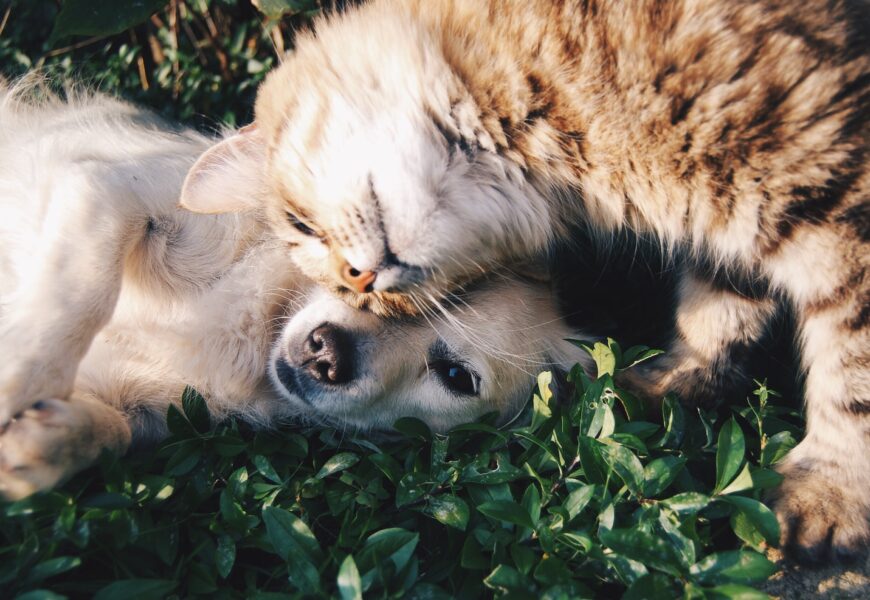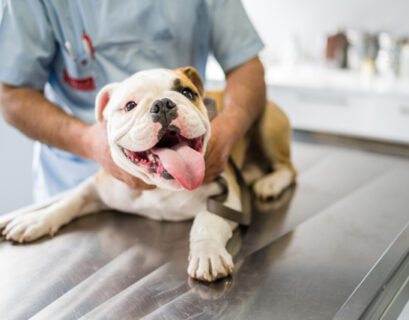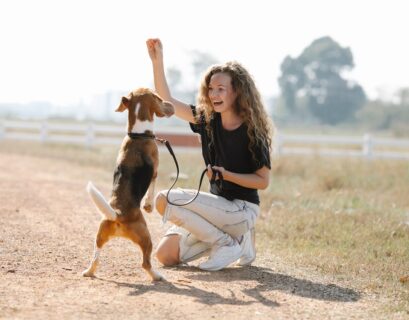Find out how to effectively introduce your dog and cat. Learn whether it’s possible to raise cats and dogs in harmony, which animal is better to obtain initially, and whether or not you can have both. Learn more by reading our helpful FAQ guide.
KEY TAKEAWAYS:
- Patience, understanding, and careful preparation are necessary for successfully introducing cats and dogs.
- Cats and dogs can coexist, but doing so takes careful introductions and understanding each animal’s space needs.
- It’s best to follow a step-by-step protocol that includes everything from exchanging scents to supervised play to make the transition as easy as possible.
- Your situation and the personalities of your current pets will determine whether you should initially have a cat or a dog.
- Compatibility between cats and dogs relies on each animal’s individuality and how they are introduced to one another.
- Answering often-asked questions like how long to leave them alone, how to handle aggressive behavior, and how to get along with other pets.
- Seek professional help if you see red flags during introductions, such as excessive fear, persistent hostility, or other concerning behaviors.
- The pets’ personality is a major factor in deciding whether or not they can live together peacefully.
Introducing a dog to a cat takes sensitivity, knowledge, and preparation. A successful introduction between these species may result in lifelong friendships, but only if done properly. This article will discuss the best ways to introduce a new dog or cat to an existing one, the most frequent worries associated with owning both, which pet should come first, and whether or not dogs and cats can live together peacefully.
Successful Steps to Having Dogs and Cats Together
There’s no reason why you can’t share your home with both a cat and a dog. They may learn to respect each other’s space and even form strong friendships, despite their diverse personalities and modes of interaction. When introducing new pets to one another, it’s important to take precautions to ensure everyone stays safe. Over time, they might adjust to living together and even bond as friends.
A Comprehensive Tutorial on Successfully Mixing Dogs and Cats
A well-planned introduction between dogs and cats will go more smoothly for everyone involved. To establish peace and tranquility, try the following:
- Provide each creature its own area with its own food, drink, litter box, and bed. This makes the pets feel safer and decreases the likelihood of first conflicts.
- Try exchanging their bedding or toys to help the dogs become used to one another’s smell before meeting face to face.
- Use a pet fence or leash to introduce the animals slowly and safely. Give them some space to see each other without having to interact.
- Use positive reinforcement by giving goodies and plenty of praise to your dogs if they behave well together at first. As a result, good memories are reinforced.
- Increase their time spent together in supervised settings over time. Make sure neither animal feels unsafe or uneasy.
- When both animals are at ease with one another, you may let them play more freely under careful observation. Calmly reorient the hostile conduct.
- Building a trusting relationship requires time and effort. Have patience and try to have a good attitude throughout.
Before the Introduction:
There is an important need to make arrangement before your pets meet and what are those? Let us tell you:
1. Set Up Private Areas:
Before introducing your new cat to your dog, ensure they have their own place. Each animal may have its own little haven like this.
2. Scent Exchange:
Switch beds or use a towel to capture odors from both pets and introduce them to each other’s living quarters. This allows them to become used to one other’s fragrance before meeting.
3. Dog’s Obedience Training:
To better control your dog’s behavior throughout the introduction, make sure they know basic commands like “sit,” “stay,” and “leave it.”
During the Introduction:
Somethings are important to keep in mind when the pets meets which are:
1. Visual Introduction:
Use a baby gate or a slightly open door to let the pets interact with one another. See how they respond and how they behave.
2. Controlled Meeting:
Have a helping hand to keep the cat in the carrier while you put the dog on a leash. Let them make eye contact from a safe distance so you can measure how they respond to one another.
3. Good Relationships:
Treat and praise both creatures for good conduct after their first introduction.
4. Short and Gradual Exposure:
Gradually increase the amount of time they spend together gradually while keeping a tight eye on their interactions. Start small and build up the length of your conversations.
5. Supervised Interactions:
You may supervise their interaction once you see that both animals are relaxed. The cat may approach if it feels safe, but the dog must remain on a leash.
6. Provide Safe Retreats: Make sure both dogs have private areas and refuges to go to if they feel uncomfortable.
After the Introduction:
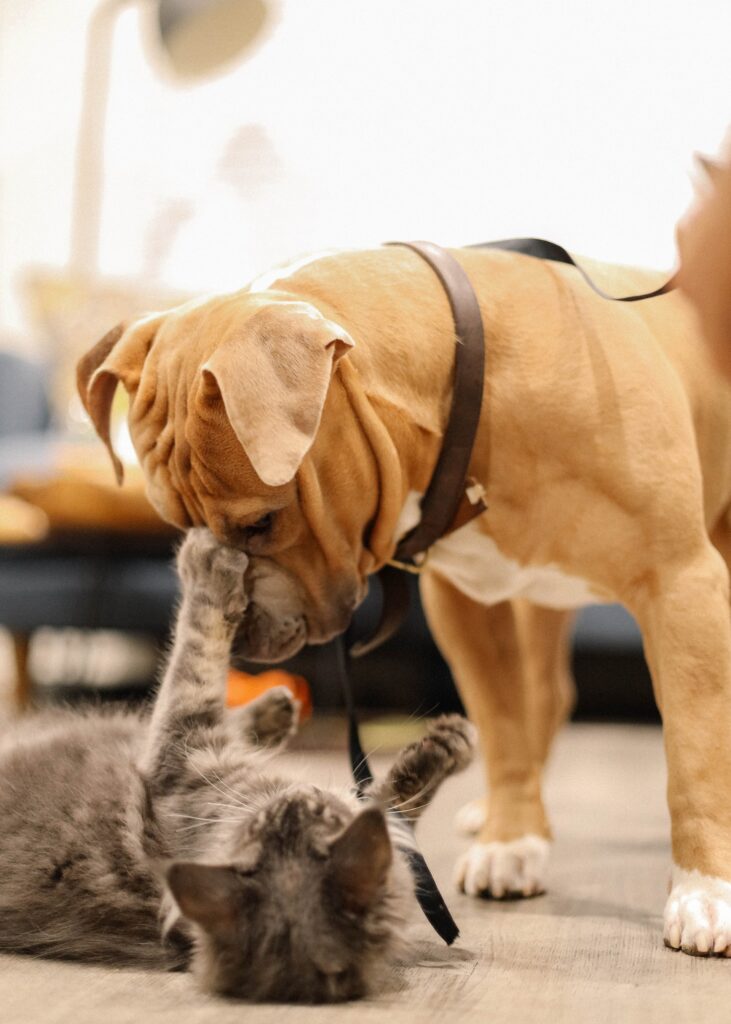
The story just does not end on the introduction but it is after the introduction that counts. Here is how you can keep it all under control:
1. Encouragement and Praise:
Keep rewarding them for getting along well and being calm around each other.
2. Gradual Increase in Interaction:
Over time, provide them more time and independence in their interactions while keeping a careful eye on them.
3. Separate Feeding Areas:
Separate feedings will discourage resource guarding among pets.
4. Monitor Body Language:
Read their nonverbal cues. Relaxed body language, leisurely blinking (in the case of a cat), and a wiggly tail (in the case of a dog) are all indicators of contentment.
5. Be Patient:
The amount of time needed for a smooth transition varies. It may take some pets some time to acclimate, while others may get along well.
Remember that the personalities and experiences of both pets have a part in how they interact. It may take some dogs and cats some time to warm up to one other, but they may become quick friends once they do. Put their well-being first, and be ready to step in if emotions escalate. To ensure a smooth transition, consult an animal behaviorist if you face excessive stress or aggressiveness.
Can Dogs and Cats Coexist Peacefully?
There’s little question that cats and dogs can coexist peacefully, but doing so takes dedication to the well-being of both species and close monitoring of their interactions. The temperament and socialization of a dog affect how well it gets along with cats. Similarly, some cats are more tolerant of canines. Remember that your pets’ personalities will play a major role in determining how well they get along. Time, instruction, and introductions may foster a harmonious living situation.
Despite their differences, cats and dogs may live together peacefully in the same home. Despite the seeming complexity of their interactions, cats and dogs may learn to live together peacefully and to each other’s benefit.
The Interactional Dynamics of Cats and Dogs
Cats and dogs have quite different modes of communication and worldviews. To introduce anything smoothly, awareness of these distinctions is essential. Dogs employ vocalizations and body postures to express themselves, whereas cats depend mostly on body language and scent marking. Misunderstandings may be avoided with proper recognition and consideration of these signals.
Overcoming Myths: Debunking Common Misconceptions
The innate hostility of cats and dogs is a common theme in urban legends about these species. It’s a common misconception that cats and dogs can’t become close friends, yet they are compatible. The introduction process is more fruitful if both parties put these myths to rest and come to it with an open mind.
Guidelines for Peaceful Cohabitation: Tips for Successful Co-Living
Making a home suitable for cats and dogs requires time, effort, and preparation. It’s important to provide each pet its own room, complete with a feeding and sleeping place. Reducing early anxiety may be aided by gradually exposing their odors to one other, followed by regulated face-to-face contact. Key components in maintaining a healthy cohabitation include positive rewards for calm conduct and progressive exposure.
Should I Get a Dog or a Cat First?
Getting a new pet is a fun and exciting adventure, but deciding between a cat and a dog may be difficult. Your lifestyle, personal tastes, and present and future pet or pets are a few of the variables that might affect your choice.
Whether you should have a cat or a dog initially depends on your lifestyle, personal tastes, and the personalities of your current pets. It’s important to think about whether or not your dog and cat might get along before introducing them. The cats might not get along with some canines since they have a stronger predatory drive. However, if you already have a cat, it is feasible to introduce a dog, provided you do it gradually and choose a breed considered to be cat-friendly.
Weighing Your Options: Things to Think About
Consider many things before choosing whether to bring a cat or dog into your household. Think about your lifestyle, how active you are, your space, and how much time you can give your new pet. Consider the personalities of your current pets and the benefits and drawbacks of each option.
Considerations for Introducing a Cat to Your Dog

Consider both pets’ personalities if you’re considering obtaining a cat before your existing dog. Because of their innate predatory instinct, some canines are not ideal housemates for felines. It’s important to take things slowly and keep a tight eye on things when introducing a cat to a dog. During this time, the cat will need somewhere to feel secure.
Bringing a Dog into a Cat’s Domain – A Careful Approach
If you already have a cat and are considering getting a dog, look for a breed known to get along well with felines. Start the introduction process slowly with shared scents and limited eye contact. Short, upbeat, and pleasant first encounters are ideal, with more time spent together to follow. Your cat’s safety and comfort should be your first priority during this transition period.
Building Bridges: The Feasibility of Coexistence
Due to their dissimilar social structures and modes of communication, cats, and dogs may struggle to get along at first. However, with forethought and slow introductions, they may learn to coexist. The trick is to arrange their first encounters in a controlled manner, to give them privacy, and to respect their personal space. Many families report that the special relationships they create with their dogs become stronger with time.
Finding the Right Match: Dog Breeds and Compatibility
Choosing a dog breed with a greater chance of getting along with cats is important before attempting to introduce them. Some dog breeds are better suited for apartment living than others because they are less aggressive and have a lower prey drive. Suppose you research and choose a breed compatible with your cat’s personality. In that case, you have a better chance of a smooth introduction and peaceful cohabitation in the long run.
Purrfect Partners: Cat Personalities in a Dog World
Cat breeds have as much variation in personality as dog breeds. Some cats are more receptive to and comfortable interacting with dogs than others. You may improve the odds of living peacefully with a new dog if you take the time to learn about your cat’s characteristics and introduce them to one gradually. Be mindful of your cat’s well-being and stress levels at all times.
Do Dogs and Cats Get Along Without Supervision?
It may seem impossible, but cats and dogs may live together happily with the appropriate attitude. Understanding the habits and likes of each species and working to create a peaceful setting are essential steps in bridging the gap between them.
Thinking of leaving your cat and dog alone for the first time is thrilling and terrifying. While peaceful coexistence should be the ultimate objective, several factors should be considered before letting them roam free.
Understanding Their Relationship Dynamics
Evaluate how well your cat and dog get along during supervised times before leaving them alone. Have there been any indications of friendship between them? It’s encouraging if they’ve been acting well toward one another and are getting along well. Additional supervised sessions and careful introductions may be required if there have been incidents of hostility or fear.
Gradual Progression, Taking Baby Steps
It’s best to ease towards leaving a dog and cat alone together. Begin with shorter intervals and lengthen them as you get experience observing their interactions. This way, they may ease into it and begin forming favorable connections. It may go more smoothly if you provide them their own room for eating, sleeping, and hiding out if they need to.
Safe Spaces
Providing your cat and dog with separate, secure areas is crucial. Food, water, a clean litter box, and cozy places to sleep are all necessities in these zones. If your pet feels anxious or overwhelmed, they will appreciate having a safe haven to return to.
Monitoring Tools
Technology may be a huge help in protecting your cats and dogs. When you can’t be there to see their interactions personally, set up surveillance cameras or use baby monitors. This will allow you to evaluate their actions, spot problems, and provide assistance if required.
Advice from Professionals:
Consult your vet or an animal behaviorist if you’re unsure whether or not it’s safe to let your cat and dog alone together. Based on their unique traits, they can determine how well they get along, provide tips for improving communication, and make specific suggestions on how to proceed.
Every cat-and-dog relationship is different. Some animals can learn to live together without human intervention, while others will always require careful monitoring. Focus on building trust and harmony by prioritizing their happiness and responding to their cues regarding body language and conduct.
Warning Signs That Living Together Isn’t Probable
While the idea of your cat and dog sharing a home is appealing, you should be aware that not all feline-canine pairings end well. Certain warning signs suggest peaceful cooperation is unlikely or will provide significant difficulties.
Persistent Aggression
It’s a major red flag if your cat or dog exhibits hostile behavior against the other regularly. Growling, hissing, barking, lunging, and even physical contact are all possible expressions of hostility. This kind of conduct suggests they cannot have a harmonious relationship and may even endanger one another.
Extreme Fear or Stress
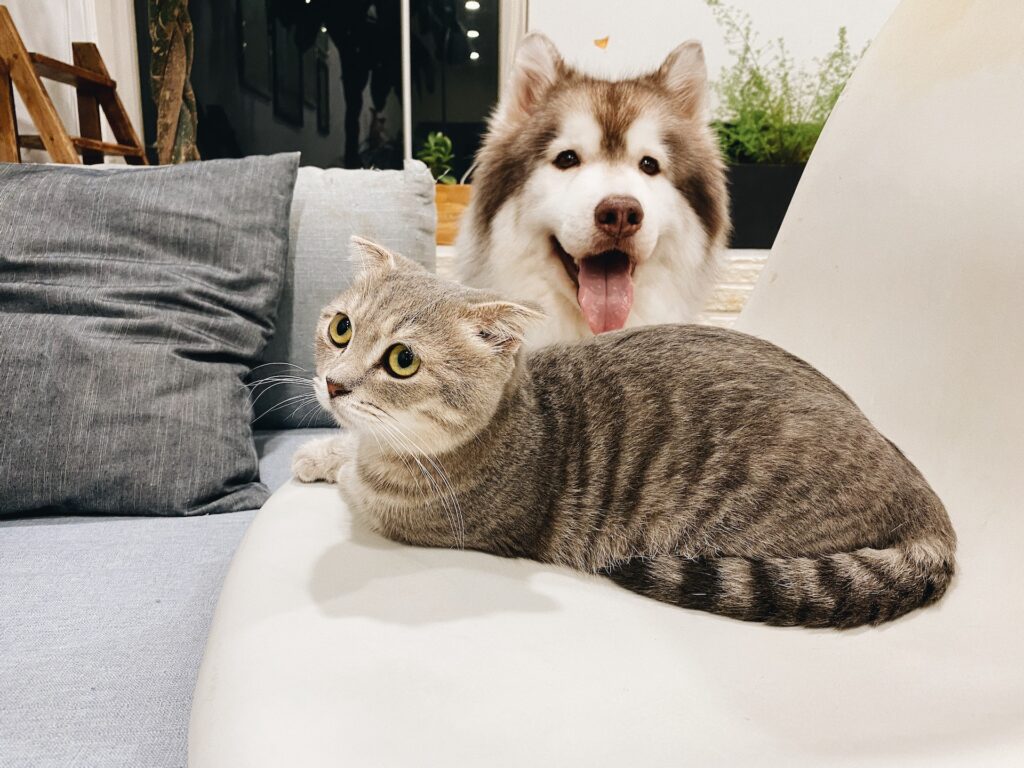
Any persistent signs of anxiety or worry from one animal while around the other should raise red flags. One pet’s inability to adjust to another’s presence is indicated by persistent hiding, trembling, or acute discomfort. Their health might suffer from prolonged stress.
Inability to Coexist
It may be a sign that your cat and dog cannot cohabit if they avoid each other and refuse to share any space. Even if they get along OK after they get to know each other, cohabitation might be difficult if they can’t even be in the same room together without showing indications of fear or anger.
Persistent Territorial Behavior
Territorial tendencies are ingrained in cats and dogs, which may lead to fights if one pet is persistently marking territory with urine, excrement, or scent glands to establish dominance. Disputes over territory may raise tensions and stress levels, making it difficult for people to live together peacefully.
Physical Injuries
It’s important to pay attention to any indicators of damage or illness shown by your cat or dog after interacting with the other. It’s normal for people to become a little testy when they first meet. Still, if the same people keep getting hurt, it might be a sign of a serious compatibility problem.
High and Uncontrollable Tension
Stress levels that don’t drop with time are a worrying sign that the pets aren’t adjusting to their new environment. It is important to treat the causes of chronic stress as soon as possible to prevent the resulting behavioral and physical consequences.
Expert Interference
If you see any of these warning signs, it’s best to consult a vet or animal behaviorist. They may look at the issue, provide advice, and see whether the pets’ personalities and actions can be tamed to where everyone can live together safely and happily. To guarantee both pets’ health and happiness, locating them in separate homes may be necessary.
Patient understanding and a well-thought-out strategy are needed when introducing dogs and cats. The appropriate care and attention may help these furry friends bond harmoniously, bringing more life and character into your home. Keep in mind that every pet is unique and that the elements that determine whether or not they will get along might vary widely. If you pay attention to their requirements and follow the advice in this article, you may make your home a happy place where cats and dogs can coexist.
The successful coexistence of cats and dogs is a testament to the power of patience, understanding, and unwavering commitment. Their unique personalities and the journey you embark on to bring them together will shape an enriching and joyful household environment. As you navigate the challenges and celebrate the triumphs, remember that the bonds formed between your furry friends are priceless.

